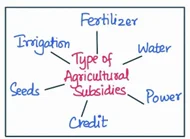Answer:
| Approach:
Introduction
Body
- Enlist the different types of agriculture subsidies
- Analyse how agricultural subsidy regime creates distortions.
Conclusion:
- Conclude saying that not all subsidies create distortions, some are really necessary.
|
Introduction:
Farm subsidy is a governmental subsidy paid to farmers to supplement farmer’s income and enhance their productivity. Farm subsidies act as a complementary income to farmers, which can be invested back in agriculture in the form of good quality inputs, thereby boosting productivity and income. Major subsidies in India are fertiliser, power, credit, output, seed, and export subsidies. In 2021 Agri-subsidies were around 5 lakh crores as per NITI Aayog ( including food and fertiliser subsidies).
Body:
On the basis of the subsidy provided, farm subsidies can be categorized into direct and indirect subsidies.
- Direct farm subsidies are those subsidies that are directly provided to farmers and are generally paid in the form of a direct cash subsidy. Example: PM Kisan Scheme, PAHAL in LPG, Farm Loan Waivers.
- Indirect subsidies are those subsidies in which the cost of the product is set at a lower price than the market price. Examples: Irrigation subsidy, Power subsidy, Fertilizer subsidy, Credit subsidy, MSP (Minimum Support Price), etc.

Issues created by subsidy regime in India:
- Diversion of money meant for boosting agriculture: There is a chance that farmers can use the money for non-farm unproductive needs.
- Increased inequality: As per Economic Survey-2018, rich farmers have benefitted more over small farmers from the farm subsidies.
- Issues like market reforms and innovation in agriculture remained unaddressed as subsidy is seen as way out from the responsibilities of the government to do this.
- A culture of subsidies promotes inefficiency and dependence on the government and also reduce the incentive to improve. Also, the government in power can provide subsidies for mere political mileage.
- Monoculture: Subsidies like MSP has led to cereal centric agriculture with distorted cropping patterns. This has led to drop in prices for these cereals while we have to be dependent on imports for many other crops earlier grown in India.
- Environmental damage: Most indirect subsidies on fertiliser, power and irrigation water contribute to the degradation of natural resources (by excessive use of subsidised resources)
- Example: Rise in soil salinity, water contamination with heavy metals and stress on groundwater aquifers in Punjab due to free power.
- Trade distortions: Policies of subsidies promote other countries to follow the same pursuit which may then lead to trade wars and protectionist policies leading to trade distortions.
- Capital investment decreased: From 1976 to 2003- subsidies increased but public investment in agriculture declined.
- The Kelkar committee recommended the phased elimination of subsidies and converting them into capital investments.
Conclusion:
The agriculture sector which provides more than 40% of employment, contributes only 16-17% of GDP. This is because of the inefficiencies in agriculture and the various issues the farmers are facing. Hence farm subsidies with an intention to improve the agriculture sector help to achieve the government’s aim of doubling the farmer’s income by 2022. Thus, there is a need for better policy deliberations with all stakeholders to reduce negative impacts, particularly on small and marginal farmers to realise an evergreen revolution with sustainable agriculture in India.
